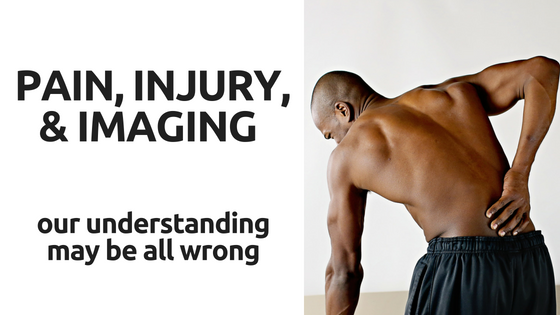As an Amazon Associate, I earn from qualifying purchases.

Many people would assume that when something hurts there is an injury; and when there is an injury it would be painful. But research and new scientific discoveries are putting a new spotlight on pain and injury, and even the methods we use to diagnose such injuries. While it’s a complex discussion with many facets, let’s keep this brief and simple.
Pain is a good thing in many ways. It is a warning that something is wrong; a survival mechanism our brain and bodies use to alter behavior and movement in order to stay alive and well.
Just because something is painful, does not mean there is an injury or dysfunction within the body. And just because there is an injury or dysfunction of some sort, does not mean you will experience pain.
Pain can be perceived when there is no physical cause for it. The brain, for any number of reasons, can interpret a sensation of pain even when there is no injury, or even when there is no body part to be painful. For example, as many as 80% of amputees report phantom sensations and pain. Even after a limb is removed, the person can still experience pain and sensation as if the limb is still there. This inexplicable sensation of pain with no cause isn’t just reserved for amputees though. Many people experience pain with no physical explanation. This may be due to physical or psychological malfunction in which the brain is interpreting something as a threat when it really isn’t.
What is Neuropathy & Can Massage Help?(Opens in a new browser tab)
On the flip side of this, people can have an injury or dysfunction within the body and experience little to no pain. For example, one study¹ had some surprising results when MRIs were conducted on seemingly healthy people. In this study, 98 people who had no back pain or other symptoms of back injury were given an MRI.
- 52% had a bulging disc
- 27% had a disc protrusion
- 38% had abnormality in more than one disc
That means that many of these people were walking around with, what most people would consider, substantial injuries/dysfunction with absolutely no symptoms of such a thing. Why? Because, more than likely, these injuries weren’t putting pressure on nerves or otherwise sending any signal to the brain that there was something wrong. Does this mean they need to rush to get these things ‘taken care of’. No! If it’s not causing pain, what would be the point? Suddenly changing behavior and the normal movement your spine is accustomed to, may actually make things worse or cause an entirely new set of problems.
How Your Lower Back Pain & Hip Pain May be Connected(Opens in a new browser tab)
Plus, there’s another side to all of this…
People assume that medical imaging such as X-rays, MRIs, and the like are reliable tests that show irrefutable evidence of a problem within the body. But did you know that studies are showing more and more that medical imaging is extremely subjective; or more specifically, because those images must be interpreted by a human being, the diagnoses associated with such images are not as reliable or irrefutable as once thought.
For example, in a study published in The Spine Journal², a patient was sent for MRIs at 10 different imaging centers over a 3 week period. This patient was a 63 year old woman with a history of low back pain and radicular (radiating nerve pain) of the right side.
The incredible but rather discouraging part of the whole thing, was the outcome.
- 49 different diagnoses
- 0 Diagnoses were consistent across all 10 reports
- Almost 1/3 of those diagnoses were reported only once
This tells us that MRI findings, and more than likely the findings of any kind of imaging, are extremely subjective and consistency of diagnoses is disheartening at best. Does this mean to ignore any findings of imaging? No. But does it mean to be cautious about jumping to conclusions and invasive or extreme treatment options? Yes.
Pain is a funny thing, and while injuries and dysfunction within the body are nothing to ignore, we also have to be careful and ask ourselves just how accurate our understanding of the problem is.
¹ Jensen MC1, Brant-Zawadzki MN, Obuchowski N, Modic MT, Malkasian D, Ross JS. “Magnetic resonance imaging of the lumbar spine in people without back pain.” New England Journal of Medicine. Published July 14, 1994 https://www.ncbi.nlm.nih.gov/pubmed/8208267
² Herzog, R., Elgort, D.R., Flanders, A.E., Moley, P.J. “Variability in diagnostic error rates of 10 MRI centers performing lumbar spine MRI examinations on the same patient within a 3-week period,” The Spine Journal. Published online Nov. 17, 2016. http://dx.doi.org/10.1016/j.spinee.2016.11.009



